How to use parsley for swelling
Parsley is a popular culinary herb. However, the use of this greenery is not limited to cooking. The plant is used in folk medicine as an anti-inflammatory, wound-healing, and diuretic.
One of the most important effects of parsley for the human body is a decrease in fluid content in tissues and organs. In this regard, infusion, decoction, compresses based on parsley are used to eliminate swelling of the legs, and masks, lotions and tonics are used to get rid of from puffiness under the eyes, on the face.
Unique properties of parsley
Parsley contains vitamins, minerals, essential oils, flavonoids, pectin, and phytoncides. These biologically active substances determine versatile medicinal properties of the plant:
- parsley increases the strength and elasticity of vascular walls and small capillaries;
- normalizes the functions of the adrenal cortex and thyroid gland;
- has a beneficial effect on the intestinal microflora;
- takes an active part in skin regeneration;
- slows down the aging process;
- neutralizes dangerous free radicals;
- has an anti-inflammatory effect;
- gives strength and elasticity to hair, protects against dehydration;
- regulates blood clotting;
- cleanses the intestines of waste and toxins;
- prevents the formation of stones in the kidneys and gall bladder;
- prevents the development of atherosclerosis, hypertension and other diseases of the heart and blood vessels;
- supports normal activity of the nervous system;
- increases endurance and performance;
- strengthens immune defense;
- takes part in the formation of steroid hormones and collagen;
- stimulates the secretion of bile;
- protects against osteoporosis.
The beneficial properties of parsley do not end there. Due to the low calorie content, dishes using it help to return to normal after overeating, lose weight, restore physical and mental strength, improve metabolism, and activate digestion.
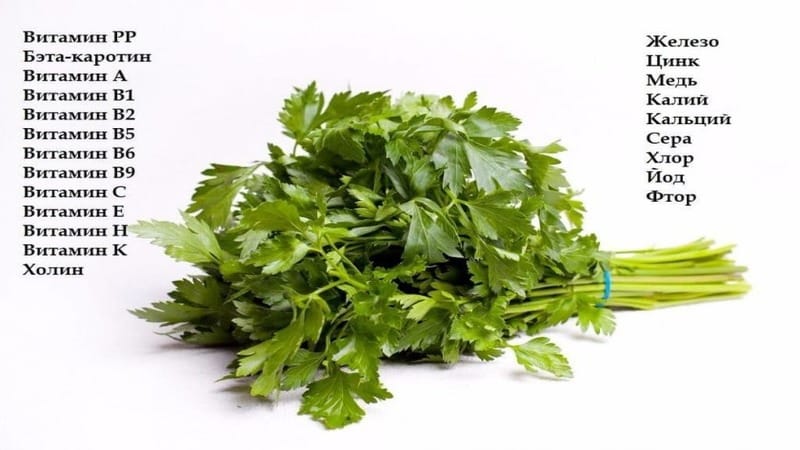
Chemical composition, vitamins and microelements
The nutritional content of 100 g of fresh parsley is presented in the table.
| Calorie content | 49 kcal |
| Squirrels | 3.7 g |
| Fats | 0.4 g |
| Carbohydrates | 7.6 g |
| Organic acids | 0.1 g |
| Alimentary fiber | 2.1 g |
| Water | 85 g |
| Ash | 1.1 g |
| Vitamins | |
| Vitamin A | 950 mcg |
| Beta carotene | 5.7 mg |
| Vitamin B1, thiamine | 0.05 mg |
| Vitamin B2, riboflavin | 0.05 mg |
| Vitamin B3, niacin | 0.7 mg |
| Vitamin B4, choline | 12.8 mg |
| Vitamin B5, pantothenic acid | 0.05 mg |
| Vitamin B6, pyridoxine | 0.18 mg |
| Vitamin B9, folates | 110 mcg |
| Vitamin C | 150 mg |
| Vitamin E | 1.8 mg |
| Vitamin H | 0.4 mcg |
| Vitamin K | 1640 mcg |
| Vitamin PP | 1.6 mg |
| Macronutrients | |
| Potassium | 800 mg |
| Calcium | 245 mg |
| Silicon | 15 mg |
| Magnesium | 85 mg |
| Sodium | 34 mg |
| Sulfur | 29.7 mg |
| Phosphorus | 95 mg |
| Chlorine | 160 mg |
| Microelements | |
| Aluminum | 425 mcg |
| Bor | 75 mcg |
| Vanadium | 24.5 mcg |
| Iron | 1.9 mg |
| Iodine | 4.3 mcg |
| Cobalt | 4.1 mcg |
| Lithium | 21 mcg |
| Manganese | 0.16 mg |
| Copper | 149 mcg |
| Molybdenum | 5.6 mcg |
| Nickel | 10 mcg |
| Rubidium | 41.5 mcg |
| Selenium | 0.1 mcg |
| Strontium | 22.2 mcg |
| Fluorine | 230 mcg |
| Chromium | 6 mcg |
| Zinc | 1.07 mg |
| Digestible carbohydrates | |
| Starch and dextrins | 1.2 g |
| Mono- and disaccharides | 6.4 g |
| Saturated fatty acids | 0.1 g |
| Polyunsaturated fatty acids | |
| Omega-3 | 0.008 g |
| Omega-6 | 0.115 g |
How parsley helps against swelling
Features and methods of treating edema with parsley depend on the causes of fluid retention in the body. Edema can be a symptom of kidney disease (renal failure, nephrosis), cardiovascular system (heart and venous insufficiency, congestion), and endocrine gland.
They can appear with excess body weight, in women against the background of hormonal imbalance, with excessive stress on the legs, injuries to the lower extremities, against the background of a sedentary lifestyle, due to wearing tight shoes, excessive consumption of salt, water in the afternoon.
Parsley decoction is used to relieve swelling in the absence of serious organ disorders or in combination with drug therapy. The plant alleviates the severity of symptoms and affects different aspects of the pathological process:
- inhibits inflammation;
- reduces the severity of pain;
- removes excess liquid;
- removes salts from the body;
- increases range of motion in the affected joint;
- normalizes metabolism at the tissue level;
- strengthens the walls of venous vessels and reduces capillary fragility;
- regulates blood viscosity and improves its trophic properties;
- participates in the processes of synthesis of fibrous fibers;
- lowers cholesterol levels, which prevents the formation of atherosclerotic plaques.
Treatment of leg swelling with parsley
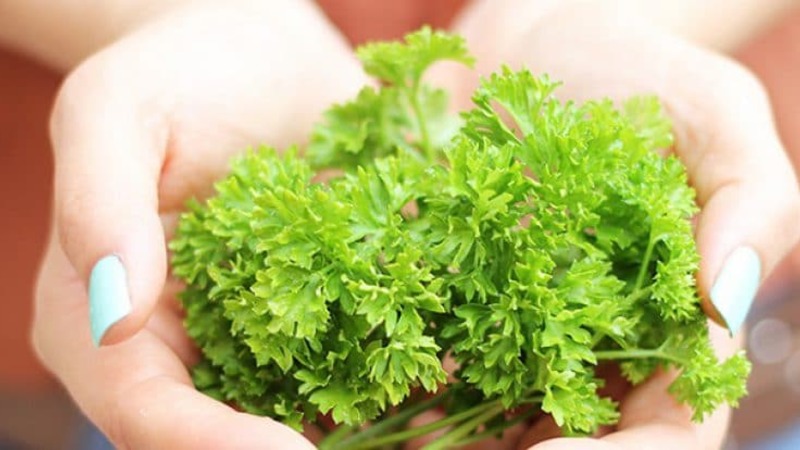
In folk medicine, all parts of the plant - roots, leaves, seeds - are used as medicinal raw materials. Their beneficial properties and chemical composition depend on varieties and product quality. For medicinal purposes, ordinary leaf or root parsley is chosen.
Advice. It is recommended to use your own parsley or buy it grown in guaranteed safe conditions without the use of nitrates and chemical plant protection products.
Infusion and decoction of roots, leaves, seeds
Recipe for making an infusion of roots and leaves:
- Rinse the parsley under running water and dry.
- Grind using a blender, meat grinder or finely chop.
- Pour the mixture with hot water in a ratio of 1:2 (two parts of water for one part of the plant). Leave covered for about an hour, then strain through gauze folded in several layers or a sieve.
The infusion is taken orally after meals, 50-75 ml three times a day until symptoms disappear completely. To speed up the outflow of excess liquid and improve taste, add 1 tsp to the infusion. honey and a few drops of lemon juice.
An infusion of parsley seeds also helps with swelling. Recipe for leg swelling:
- 1 tbsp. l. pour a glass of boiling water over the seeds.
- Place on low heat, and after boiling, cook for 5-10 minutes.
- Leave and strain.
Drink 1/3 cup three times a day before meals.
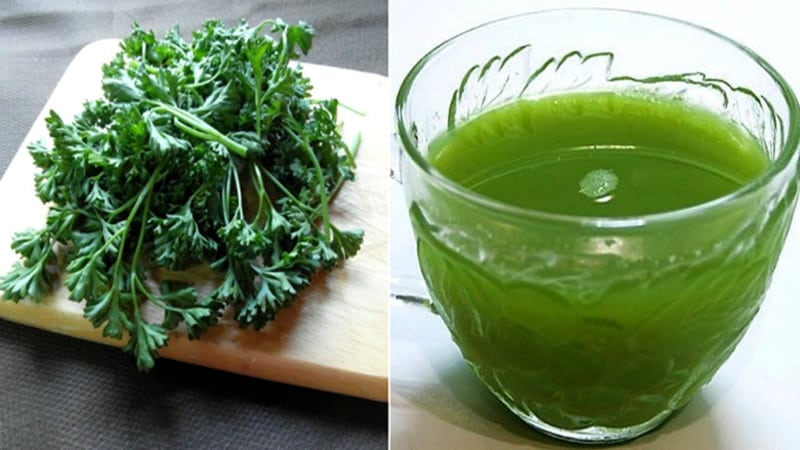
Decoction with milk
A decoction of parsley in milk is used as an anti-inflammatory and diuretic to relieve joint pain. To prepare, you will need 100 g of greens and 250 ml of milk (preferably homemade).
How to prepare a decoction of parsley to relieve swelling:
- Sort the greens, remove foreign debris, limp and damaged leaves. Rinse well and rinse with boiling water.
- Finely chop the leaves, place in a heat-resistant container, pour in milk and stir.
- Place the broth in a preheated oven and simmer at 150°C until thickened.
- Take the strained decoction orally every 1-1.5 hours, 2 tbsp. l.
Decongestant tea
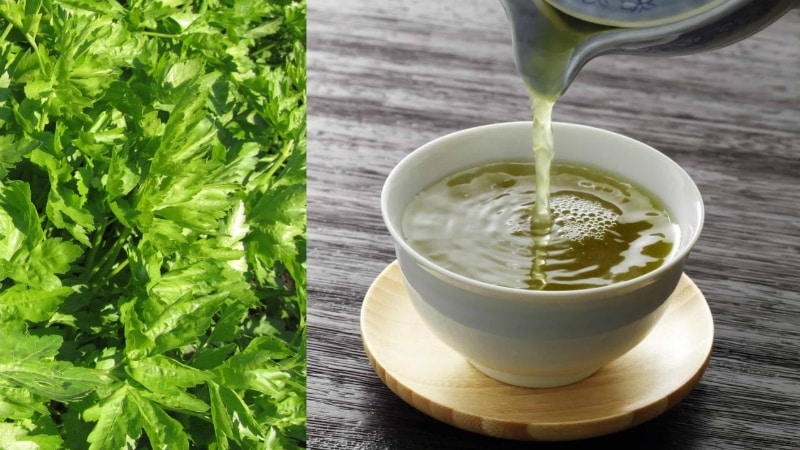
To prepare a medicinal drink, all parts of the plant are used - roots, greens and seeds.
Decongestant tea recipe:
- Wash the parsley root and leaves and grind in a blender or meat grinder.
- 1 tbsp. l. pour the resulting mixture into a container, add 1 tbsp. l. parsley seeds and the same amount of loose leaf black tea, mix all ingredients.
- Pour 900 ml of boiling water. Leave covered for 7-10 minutes. Strain.
Tea is taken warm, 200-250 ml every two hours. If desired, add mint leaves, lemon balm, lemon, and honey to the tea.
External means
For swelling of the legs, a compress made from a decoction or infusion of roots, herbs, or seeds of the plant helps. All parts are mixed in equal proportions.
How to make a compress:
- Moisten a cloth folded in several layers in a warm decoction (infusion), squeeze lightly, and apply to the site of swelling.
- Cover the top with wax paper or cellophane.
- Attach all layers tightly to the leg with a few turns of the bandage, and wrap with a warm scarf. After 6-8 hours, remove the compress.
Parsley gruel relieves swelling:
- Wash the greens, dry them, puree them in a blender or grind them in a meat grinder.
- Apply the paste to the area of fluid accumulation on the leg.
- Place the second layer of oilcloth, followed by a thick layer of cotton wool.
- Secure the top with a bandage and wrap it in a woolen scarf.
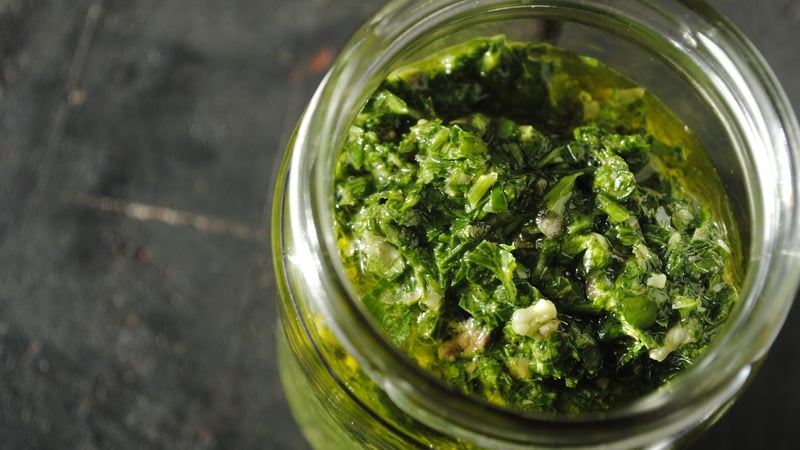
Eliminating facial swelling with parsley
Parsley cosmetics serve as an alternative to expensive cosmetic products and improve skin condition. Masks and lotions prepared at home have a complex effect on the body.
In addition to its main effect (decongestant), parsley saturates the skin cells with moisture, nourishes, tones, and as a result, the skin becomes elastic, acquires a beautiful healthy color and radiance.
For reference. Vitamin K present in the plant prevents excessive pigmentation, folic acid protects against the negative effects of sunlight, and retinol along with vitamin C stimulate collagen production.
Mask with sour cream
This mask is suitable for those with dry skin and women over 30, when the skin begins to change due to age. Sour cream contains a lot of vitamin E. It prevents the development of senile pigmentation, slows down the aging process, normalizes cellular metabolism, and whitens the skin.
How to make a mask:
- Rinse the parsley and remove any remaining moisture with a paper towel. Finely chop.
- In a clean, dry container, mix 1 tbsp. l. chopped parsley with 1 tbsp. l. fat sour cream. If desired, add half of the grated cucumber.
- Apply the mask to the face and neck area. Leave for 20 minutes. Rinse off any remaining residue with warm water. Apply moisturizing cosmetic cream to dry skin.
Lotion with parsley and tea
Natural homemade tonic relieves puffiness, accelerates healing processes, stops premature aging, has an anti-inflammatory effect, and tones the skin.
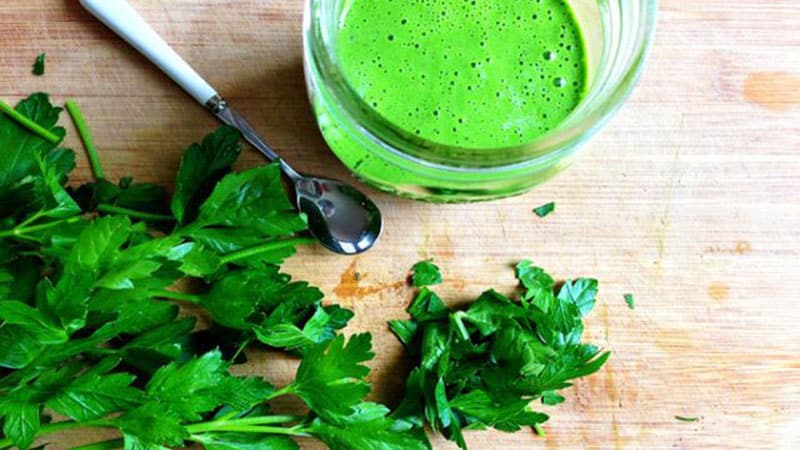
Recipe:
- Warm up the kettle, pour a pinch of tea into a cup, pour 200-250 ml of boiling water. To cover with a lid.
- Fill the glass halfway with finely chopped parsley (you can use greens along with the rhizome). Pour hot tea on top. Leave covered for about an hour.
- Apply lotion to a cotton pad and wipe pre-cleansed and dry facial skin along massage lines. Repeat the procedure twice a day - morning and evening.
The remaining product is stored in the refrigerator in a sterile sealed container.
Compress
To prepare a compress, use a decoction of parsley root or greens:
- Wash the root and leaves well, dry, and grind in a blender.
- Measure out 1 tbsp. l. mixture, pour a glass of boiling water. Put on fire. After boiling, simmer for 10-15 minutes.
- Cover with a lid, cool and strain.
- Moisten gauze folded in several layers or any thin fabric in a warm broth. Squeeze lightly, place on face and hold for 10-15 minutes.
When the compress is on the face, it is recommended to lie down, relax and not talk. This will improve the effect of the composition.
Possible harm and contraindications
Negative side effects when using parsley are rare. In isolated cases, allergies are observed: itching, rashes and peeling of the skin.
Eating parsley, infusions and decoctions based on it will not harm a healthy body, but there are some contraindications. Use with caution is recommended parsley for pregnant women, especially in later stages. The active components stimulate uterine contractions, which can cause premature birth and spontaneous abortion.
For women during pregnancy, external use of parsley in the form of masks will be useful. for face, compresses for feet.
It is not recommended to take medicinal products using parsley if:
- individual intolerance to the product;
- jades;
- diseases of the urinary system in the acute stage;
- low blood pressure;
- severe urolithiasis.
External use of parsley is contraindicated in the presence of skin diseases or injuries (wounds, abrasions, ulcers) at the site of use.
Conclusion
Parsley for swelling is an effective, simple and inexpensive remedy.All its parts have a pronounced diuretic effect, have a positive effect on hematopoiesis, increase the strength and elasticity of capillaries and vascular walls, tone the skin, and accelerate regeneration processes.
However, when swelling is a symptom of a disease, parsley alone will not be enough. Adequate and timely treatment prescribed by a doctor is important. If necessary, he can recommend a parsley decoction in combination to relieve swelling.